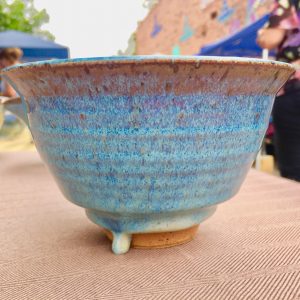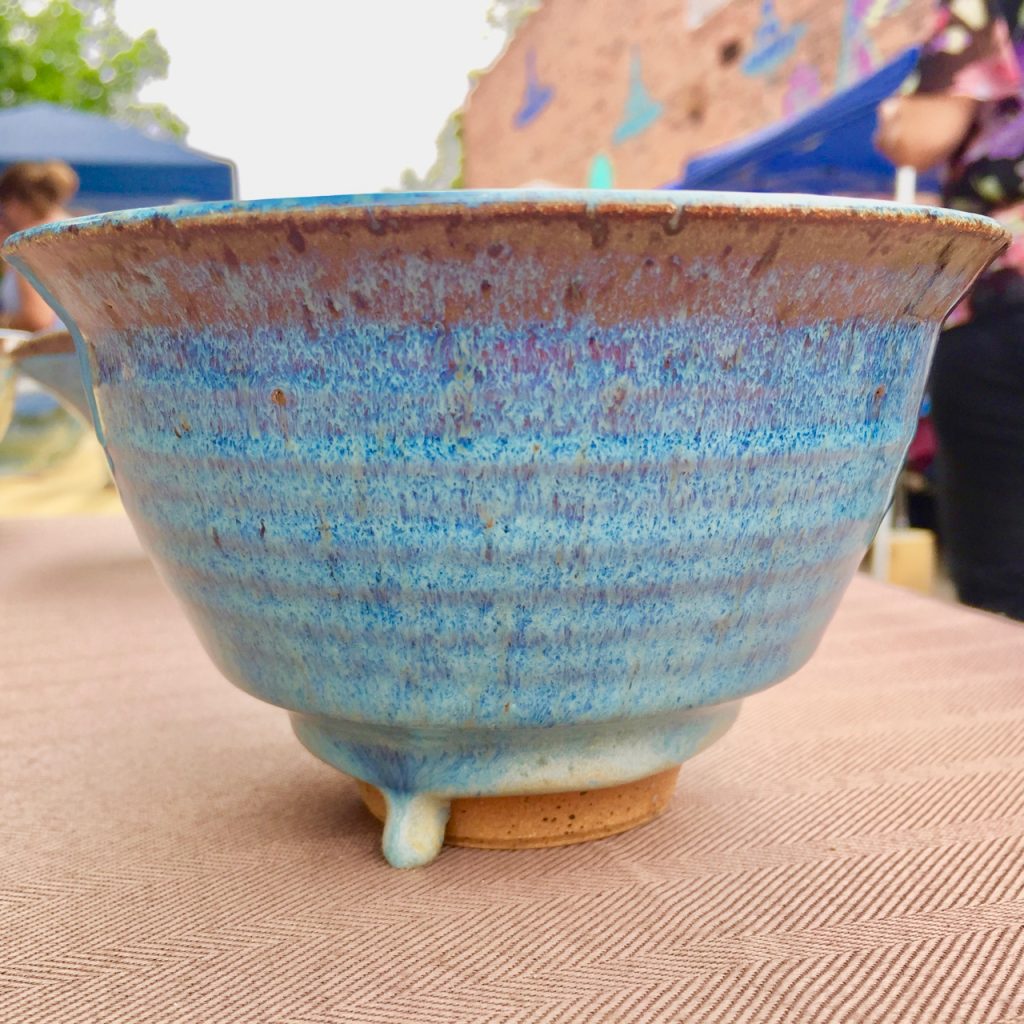This originally appeared as part of the Daily Sip, a website from Charles LaFond, an Episcopal Priest who raises money for the homeless and lives on a horse farm in New Mexico with his dog Kai. offering daily meditations and reflections
 Of the thousands of pots I have thrown on my potter’s wheel, this recent simple tea bowl is one of my favorites. The opal glaze catches the New Mexican sunlight in ways which stop me in my tracks. I wanted a deep wall to this bowl and I wanted this opal glaze washing over its sides. But the choices, together, were dangerous. I knew, going into the firing process that if I used this pot, with its tall, vertical sides along with this glaze and its melting tendencies to flow and drop… well, there might be trouble. I took the risk. The risk was that the glaze would drip down in the kiln-firing and fuse the bowl to the shelf, breaking the pot as it cooled. Risky.
Of the thousands of pots I have thrown on my potter’s wheel, this recent simple tea bowl is one of my favorites. The opal glaze catches the New Mexican sunlight in ways which stop me in my tracks. I wanted a deep wall to this bowl and I wanted this opal glaze washing over its sides. But the choices, together, were dangerous. I knew, going into the firing process that if I used this pot, with its tall, vertical sides along with this glaze and its melting tendencies to flow and drop… well, there might be trouble. I took the risk. The risk was that the glaze would drip down in the kiln-firing and fuse the bowl to the shelf, breaking the pot as it cooled. Risky.
But I went for it anyway! That is what artists do sometimes. We take a deep breath and we write something or make something which is risky. Sometimes it is a flop and we lick our wounds and sometimes the risk of danger is worth the outcome – the art. And this “art” of which I speak need not be limited to what sits or hangs in an “art gallery.” We are all artists. Every last one of we eight billion people, we are maker-sapiens and we are making lives every day. We make babies who become wonderful creations of their raising. Or not. We make meals. We make experiences. We make love. We make businesses, non-profits, churches, neighborhoods – we make all sorts of things. Each one of us. Every day. I am a potter and a fundraiser so, I make pots and raise money. How do I know I am a potter? Because I can’t-NOT make pots. I can’t not midwife philanthropy.
“Can’t-not” is a good indicator of an artist when what they are producing is beautiful and soul-full. Of course there is also the dark side of “can’t-not.” Addictions, gangs and crime, temptations, even simple, poor choice-making. I can’t-not make pots. But also, I can’t-not feel anger when I am hurt or manipulated by others – especially by the Church. What to do with THAT “making?” Well, it is one thing to feel anger, but another thing entirely to hold on to it and rock it in my arms for days like the corpse of a dead, rotting baby. Annie, a spiritual director from my youth once said “Charles, you warm yourself by the fires of your own resentments.”
Then, 30 years later my current Spiritual Director sent me this:
“Of the seven deadly sins, anger is possibly the most fun. To lick your wounds, to smack your lips over grievances long past, to roll over your tongue the prospect of bitter confrontations still to come, to savor the last toothsome morsel; both the pain you are given and the pain you are giving back – in many ways it is a feast fit for a king. The chief drawback is that what you are wolfing down is yourself. The skeleton at the feast is you.” Frederick Buechner, Wishful Thinking
Hmm.
The potter, when removing this bowl from the kiln would be tempted to grind off the drip of the glaze. It will one day break off leaving a jagged, sharp spine of broken glass right where fingers go (glaze is just glass and chemicals.) I have chosen instead to keep the drip and to be very careful with the tea bowl, using it only on special occasions. It has a message for me.
It sits at my meals. It holds my tea. It reminds me of the tears I have shed over what I have had done to me and what I have done to others. The bowl and its drip are like an icon, pointing to a different kind of meal.
Acknowledging the tears without holding the anger is the difference between two life-meals. In one I leave the anger and grievances outside with the coyotes and scorpions, preferring my meal to be joyful or at least peaceful. In the other, I collapse to my sins and infect the meal with anger and broken glass shards or resentment. Cut fingers. Cut soul.
Daily, to the best of my ability (and often I fail!) I try hard to feast on joy and leave anger and resentment to the coyotes and scorpions, howling and scratching respectively on the mesas near this small farm in New Mexico. This small desert place – this laboratory of my conversion.

